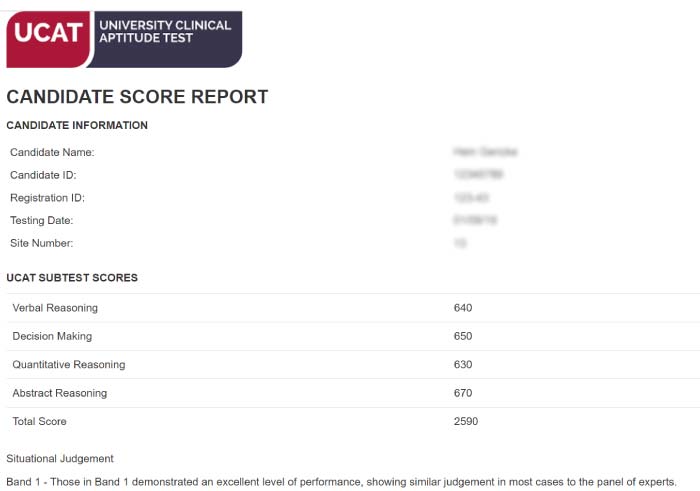How is the UCAT scored? How do universities use the UCAT? What does the UCAT score mean?
These are some important questions for people wanting to sit the UCAT. Knowing how the UCAT is scored and what a good, bad or average score is can help you do the best you can. Your score can help you tailor how you prepare for the exam and later, help you decide which universities to apply to.
In this article, we will discover the mechanisms of the UCAT scoring system, the essentials you need to know and how different universities use this notorious admissions test in their applications process.
The Structure Of The UCAT
As you will already know, the UCAT is 2 hour computer-based exam which is split into five sections:
These 5 sections each test different abilities relevant to being a doctor or dentist.
It’s important to note that each subsection is scored separately which means that doing well in each section individually, as well as getting a high overall score, is key.
Want to boost your UCAT Score?
Prepare yourself for the UCAT with comprehensive resources, an expert preparation course and full access to UCAT.Ninja, available as soon as you sign up.
UCAT.Ninja
UCAT.Ninja
Want to boost your UCAT Score?
When you sign up to 6med’s UCAT Bundle, you’re getting access to live courses, video Masterclasses, an expert workbook and UCAT.Ninja, the world’s best UCAT preparation platform!
Does this sound like the perfect UCAT preparation support?


When Do You Get Your UCAT Results?
One good thing about this exam is that you get your results as soon as you leave the test room, so there’s no waiting required!
When you receive your results, you get a score reporting your individual numerical scores for the first 4 subsections from 300 to 900 and a Band for Situational Judgement from 1 to 4.
Your numerical scores will also be added together to give you an overall score from 1200 to 3600 which is what a lot of universities look at during applications.
To know exactly what this means for your medical school application and how you did versus other candidates, you will have to wait for the final test statistics to come out which happens about a week after the testing period ends.
This contains the average overall and subsection scores for that year with decile rankings to help place your score relative to everyone else.
The image below is what you’ll receive from Pearson VUE upon sitting and completing your UCAT exam. It’ll tell you your individual section scores, along with a total score.

How Is The UCAT Scored?
The UCAT scoring system doesn’t directly correlate to the number of questions you get correct or incorrect.
The score for a person that got 50% of the questions correct one year would be different to someone else with 50% correct another year.
The process of converting raw marks into a UCAT score is very much like calculating grade boundaries for GCSEs.
Read on to see how the first Verbal Reasoning, Decision Making, Quantitative Reasoning and Abstract Reasoning sections are scored versus the final Situational Judgement section.
How Is Each UCAT Section Scored?
Scoring For Verbal Reasoning, Decision Making, Quantitative Reasoning & Abstract Reasoning Sections
The scoring for Verbal Reasoning, Decision Making, Quantitative Reasoning and Abstract Reasoning is the same.
Essentially, raw marks are scaled and converted into a score between 300 and 900 using a designated group of “test takers” that help the exam board judge how hard the exam is that particular year. On the day, your raw mark will be converted to a UCAT score based on how well you did compared to the average score of the sample of “test takers” of that year.
The mean score (or average) of the group corresponds to a score of 600 with one standard deviation to either side of the mean correlating to 500 and 700. This overall score meanwhile is the combination of all 4 scores combined into one. You’ll see these scores a lot when looking into the statistics of the previous exam cycles. At the end of the day however, these two values are interchangeable.
Keep in mind that you don’t need to get all the questions correct to get 900 in a section. In practice, this means that you can skip hard or time-consuming questions as not all the questions are designed to be completed in the time. However, to maximise your chances of a high score, you should attempt all questions.
The image below shows the minimum, maximum and median score for the UCAT (along with the average score successful candidates get).
Scoring For Situational Judgement
For the Situational Judgement section, the same process applies but instead of a numerical score, you are awarded a Band from 1 to 4 with Band 1 being the best and Band 4 the worst.
This subsection tests your judgement of different ethical or team scenarios and compares them to what a doctor would do in each situation. So the closer you are to what the panel of doctors said they would do, the higher a band you get.
One of the main points to note about the scoring of the UCAT is that there is no negative marking. So leave no question blank and you might pick up a few extra marks at no extra cost.
Here are the official definitions for the UCAT Situational Judgement (SJT) bands:
BAND 1
(BEST)
Those in Band 1 demonstrated an excellent level of performance, showing similar judgement in most cases to the panel of experts.
BAND 2
Those in Band 2 demonstrated a good, solid level of performance, showing appropriate judgement Frequently, with many responses matching model answers.
BAND 3
Those in Band 3 demonstrated a modest level of performance, with appropriate judgement shown for some questions and substantial differences from ideal responses for others.
BAND 4
(WORST)
The performance of those in Band 4 was low, with judgement tending to differ substantially from ideal responses in many cases.
As we’ve seen, the UCAT is scored in a fairly unique way and not all of the information relating to it is available publically. Specifically, UCAT has not explicitly detailed the figures used when converting your raw marks (e.g. the average marks and standard deviation).
You will find various UCAT Conversion Tables online, but understand that these are not official resources and are most likely to be estimations based on previous years’ results. While this can be helpful during your practice, they do not accurately reflect how your marks will be converted for your UCAT.
Also, be wary of UCAT Conversion Calculators unless officially created by UCAT. Most of the time these will not take scaling into account when calculating your score, instead using basic code to display a predetermined score like the example below:
else if (s <= 33) sc = 750;
What Can We Learn From Past UCAT Scores?
Here are the average scores from the past 5 years’ UCAT cycles, including the most recent year (2023);
| Section | 2022 | 2021 | 2020 | 2019 | 2018 |
|---|---|---|---|---|---|
| Verbal Reasoning | 567 | 572 | 571 | 565 | 567 |
| Decision Making | 616 | 610 | 627 | 618 | 624 |
| Quantitative Reasoning | 658 | 665 | 666 | 662 | 658 |
| Abstract Reasoning | 659 | 651 | 655 | 638 | 637 |
| Situational Judgement | Band 2 | Band 2 | Band 2 | Band 2 | Band 2 |
| Mean Overall Score | 2500 | 2499 | 2519 | 2483 | 2485 |
When we look at all these scores, we can see that the mean scores for each section tend to stay in a similar range throughout the years. Any changes that do occur don’t seem to have any pattern or trend to analysis, so it’s safe to say that these scores represent the general averages for the UCAT as a whole. We can also see that each year, the most common Situation Judgement score was Band 2, which is a good score to get.
The other information published by the UCAT Consortium is the table of deciles. This splits everyone that took the test into 10% increments. Last year’s information tells us that most people scored around the average with very few people getting very low or very high scores.
But what does this mean for you?
Well, it means that it is hard to get a very bad score (which is good) but also hard to get an amazing score. So the preparation you put in should focus on getting the best score on the day as a few questions could be the difference of getting a place at medical school or not.
UCAT Percentiles and Decile Rankings
One method of ranking used in the UCAT is the Percentile and Decile Ranking system. Your score will fit into a certain percentile that compares your performance to every other applicant.
This can be converted into the percentage of applicants that you have scored higher than, so a higher percentile score means a higher UCAT score. As an example, scoring in the 80th Percentile means you scored higher than 80% of other applicants.
From there, the Decile Ranking system essentially organises all of the UCAT Percentiles into 9 different ranks. Each rank is made up of 10% of applicants and is ordered from the lowest average to the highest average scores.
Essentially, if you scored within the 1st Decile rank, you will scored within the bottom 10% of applicants. Being in Rank 9 means you scored in the top 10% and scoring in the 5th means you got an average overall score.
Here’s the UCAT 2022 Decile Table if you’re interested to see the boundaries for the previous admissions cycle.
| Decile Rank | 2022 Final Scores | 2022 Actual Percentile |
|---|---|---|
| 1st | 2120 | 10th |
| 2nd | 2250 | 20th |
| 3rd | 2340 | 31st |
| 4th | 2420 | 40th |
| 5th | 2500 | 50th |
| 6th | 2570 | 60th |
| 7th | 2660 | 70th |
| 8th | 2750 | 80th |
| 9th | 2880 | 90th |
Boost your UCAT score with expert support from 6med.
Learn everything there is to know about the UCAT, with our UCAT Bundle and be guided by a tutor who scored in the top 10% – meaning you’re truly getting expert help.
UCAT Crash Course
UCAT Crash Course
Looking for the best way to improve you UCAT skills?
Learn everything there is to know about the UCAT, with our UCAT Bundle and be guided by a tutor who scored in the top 10% – meaning you’re truly getting expert help.
Want to learn how to smash the UCAT, then this bundle is the one for you…


What are Good, Average and low UCAT Scores?
In the UCAT, there is commonly believed to be three major tiers of UCAT score that will determine the quality of your performance. These are calculated by a number of factors, including university cut-off scores for the test and average scores for applicants who received an interview or an offer.
What is a Good UCAT Score?
Firstly, there are Good (or High) UCAT Scores. A good UCAT score is generally considered to be around 660, or an average of 2600 or more. Basically, scoring in the top 3 Deciles of the UCAT is going to make your application very competitive. Going even further, an Excellent score is anything above 2,800 or a 700 average which would pass almost all university UCAT thresholds.
What is an Average UCAT Score?
An Average UCAT score is naturally going to be anything between a High and Low score! Therefore, any score between 620-660, or 2200-2600 overall. This doesn’t look like a very big range at first glance, but the majority of UCAT scores do fall between these two points, making the average scores the most common.
What is a Low UCAT Score?
Lastly, a Low score is going to fall below 2200 overall, or 620 per section. A low score is definitely going to limit your options for study but it doesn’t spell death for your application. A low score isn’t going to get you into most universities with defined cut-off scores but there are plenty of universities that don’t employ a threshold. As long you develop a strong application to support this score, then an interview is never out of the question.
Remember that your UCAT score can be presented in two different ways. Your average or mean is the average of your score from the first four sections of the UCAT. This score will typically sit around 500 – 700 (although your score could go to an extreme in either direction).
Your overall score is the combination of each section, which will typically sit within the 2000s. This, of course, does not take your SJT result into account.
Neither one is more important than the other, but it’s important to understand what each one means when you’re doing your research.
The other thing to consider is that you still have a chance to perform well in a medical school admissions test, as you can also sit the BMAT. Sitting the BMAT will give you the opportunity to apply to some of the top medical schools in the country, including Oxford, Cambridge and University College London. Preparation is key for this test, which is where practice and revision resources, such as those included in our BMAT Bundle, will be extremely useful for cementing your success.
The Situational Judgement section is a different beast entirely within the UCAT. As we know, it has a unique scoring system, meaning these tiers aren’t going to be relevant to your SJT result. This, of course, is replaced by the Bands system.
Scoring within Bands 1 and 2 would be considered a desirable result, as either of these will be accepted by any UCAT University. Band 3 would be considered average and scoring within Band 4 will have a pretty big impact on which universities you can apply for, which we will discuss further below.
No matter what the statistics end up saying though, it’s always wise to aim for the best possible score! You can greatly improve your revision strategy by utilising all the tools included in 6med’s UCAT Bundle. Check out what you’ll be getting today!
Where to Apply with Good, Average and Low UCAT Scores
Universities all have slightly different admissions processes and use the UCAT in different ways. It’s important to take a look at previous years’ data to see which universities require high UCAT scores and which ones accept lower scores in order to plan your choices carefully.
You can find a full breakdown of how each University specifically uses the UCAT, as well as statistics from previous exam cycles, in our guide to How Universities use the UCAT. However, let’s take a look at which medical schools consider Good, Average and Low Scores.
Good Score UCAT Universities
Average Score UCAT Universities
Low Score UCAT Universities
These rankings can very easily change depending on various factors, such as if a university changes its cut-off score or if its average scores rise or lower. However, as the data currently shows, this is an accurate representation of how high of a score you will roughly need to gain an interview at each UCAT university.
A higher score might make universities that put a large weighting on the UCAT more appealing while a lower score might mean that you could waste a precious space on your UCAS form to a university that will likely reject you.
Situational Judgement Requirements
This is all in relation to the first four sections of the UCAT however. Once again, the Situational Judgment test stands out. Many universities state that they will not accept applicants who score within Band 4 of the SJT. This means that scoring low in this section, even if the rest of your score is average or high, will block you out of many potential unis. This list shows each university that enforces this minimum SJT Requirement:
Medical Schools Which Do Not Accept Band 4 SJT
- Anglia Ruskin University
- Edge Hill University
- Keele University
- University of Leicester
- University of Liverpool
- University of Nottingham
- Brunel University London
- Hull and York Medical School
- Kent and Medway Medical School
- University of Lincoln
- University of Manchester
- University of Sunderland
On the other side of this, many Universities that aren’t on this list will not consider the SJT at all or will do so in specific cases or settings. For example, the University of Sheffield and the University of Birmingham will consider your SJT score post-interview when deciding who to give offers to. Meanwhile, The University of Bristol and the University of Glasgow are unlikely to consider your result at any stage in the application process.
However, it’s still very important that you have a look at some Situational Judgement questions before you walk into the exam room It could be a deal-breaker for many universities when applying to Medical and Dental school.
Conclusion
So, in summary, the first 4 subsections of the UCAT are given numerical scores between 300 and 900 with the last being allocated a Band from 1 to 4. Universities use the UCAT in different ways with some putting more emphasis on it than others. A higher score is better so leave no question unanswered!
Thank you for reading the article and we at 6med hope it has cleared some things up about the UCAT exam.
If you want more information on the UCAT, then please check out our other articles or the official UCAT website. And if you’re looking for comprehensive help with your preparation, 6med’s UCAT Bundle will provide you with everything you’ll need to get a great score!
Want to boost your UCAT Score?
Prepare yourself for the UCAT with comprehensive resources, an expert preparation course and full access to UCAT.Ninja, available as soon as you sign up.
UCAT.Ninja
UCAT.Ninja
Want to boost your UCAT Score?
When you sign up to 6med’s UCAT Bundle, you’re getting access to live courses, video Masterclasses, an expert workbook and UCAT.Ninja, the world’s best UCAT preparation platform!
Does this sound like the perfect UCAT preparation support?

